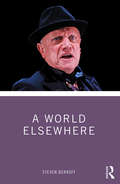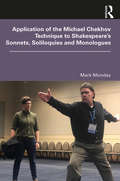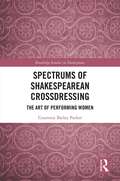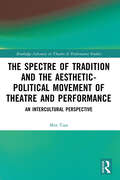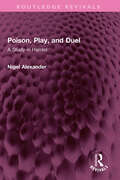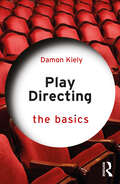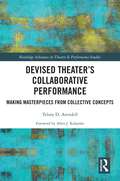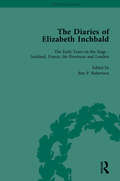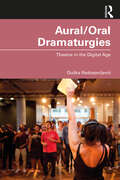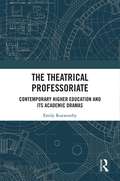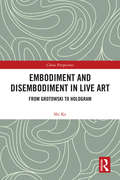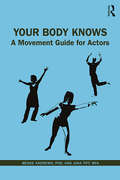- Table View
- List View
A World Elsewhere
by Steven BerkoffA World Elsewhere is Steven Berkoff’s bold attempt to describe his multifarious theatrical works. Berkoff outlines the methods that he uses, first of all as an actor, secondly as a playwright and thirdly as theatre director, as well as those subtle connections in between, when one discipline melds effortlessly into another. He examines the early impulses that generated his works and what drove him to give them form, as well as the challenges he faced when adapting the work of other authors. Berkoff discusses some of his most difficult, successful and unique creations, journeying through his long and varied career to examine how they were shaped by him, and how he was shaped by them. The sheer scale of this book offers a rare experience of an accomplished artist, combined with the honesty and insight of an autobiography, making this text a singular tool for teaching, inspiration and personal exploration. Suitable for anyone with an interest in Steven Berkoff and his illustrious career, A World Elsewhere is the part analysis and part confession of an artist whose work has been performed all over the world.
Application of the Michael Chekhov Technique to Shakespeare’s Sonnets, Soliloquies and Monologues
by Mark MondayApplication of the Michael Chekhov Technique to Shakespeare’s Sonnets, Soliloquies, and Monologues illustrates how to apply the Michael Chekhov Technique, through exercises and rehearsal techniques, to a wide range of Shakespeare’s works. The book begins with a comprehensive chapter on the definitions of the various aspects of the Technique, followed by five chapters covering Shakespeare’s sonnets, comedies, tragedies, histories, and romances. This volume offers a very specific path, via Michael Chekhov, on how to put theory into practice and bring one’s own artistic life into the work of Shakespeare. Offering a wide range of pieces that can be used as audition material, Application of the Michael Chekhov Technique to Shakespeare’s Sonnets, Soliloquies, and Monologues is an excellent resource for acting teachers, directors, and actors specializing in the work of William Shakespeare. The book also includes access to a video on Psychological Gesture to facilitate the application of this acting tool to Shakespeare’s scenes.
Application of the Michael Chekhov Technique to Shakespeare’s Sonnets, Soliloquies and Monologues
by Mark MondayApplication of the Michael Chekhov Technique to Shakespeare’s Sonnets, Soliloquies, and Monologues illustrates how to apply the Michael Chekhov Technique, through exercises and rehearsal techniques, to a wide range of Shakespeare’s works. The book begins with a comprehensive chapter on the definitions of the various aspects of the Technique, followed by five chapters covering Shakespeare’s sonnets, comedies, tragedies, histories, and romances. This volume offers a very specific path, via Michael Chekhov, on how to put theory into practice and bring one’s own artistic life into the work of Shakespeare. Offering a wide range of pieces that can be used as audition material, Application of the Michael Chekhov Technique to Shakespeare’s Sonnets, Soliloquies, and Monologues is an excellent resource for acting teachers, directors, and actors specializing in the work of William Shakespeare. The book also includes access to a video on Psychological Gesture to facilitate the application of this acting tool to Shakespeare’s scenes.
Spectrums of Shakespearean Crossdressing: The Art of Performing Women (Routledge Studies in Shakespeare)
by Courtney Bailey ParkerSince young male players were the norm during the English Renaissance, were all cross-dressed performances of female characters played with the same degree of seriousness? Probably not. Spectrums of Representation in Shakespearean Crossdressing examines these varied types of female characters in English Renaissance drama, drawing from a range of play texts themselves in order to investigate if evidence exists for varying performance practices for male-to-female crossdressing. This book argues for a reading of the representation of female characters on the English Renaissance stage that not only suggests categorizing crossdressing along a spectrum of theatrical artifice, but also explores how this range of artifice enriches our understanding of the plays. The scholarship surrounding cross-dressing rarely makes this distinction, since in our study of early modern plays we tend to accept as a matter of course that all crossdressing was essentially the same. The basis of Spectrums of Representation in Shakespearean Crossdressing is that it was not.
Spectrums of Shakespearean Crossdressing: The Art of Performing Women (Routledge Studies in Shakespeare)
by Courtney Bailey ParkerSince young male players were the norm during the English Renaissance, were all cross-dressed performances of female characters played with the same degree of seriousness? Probably not. Spectrums of Representation in Shakespearean Crossdressing examines these varied types of female characters in English Renaissance drama, drawing from a range of play texts themselves in order to investigate if evidence exists for varying performance practices for male-to-female crossdressing. This book argues for a reading of the representation of female characters on the English Renaissance stage that not only suggests categorizing crossdressing along a spectrum of theatrical artifice, but also explores how this range of artifice enriches our understanding of the plays. The scholarship surrounding cross-dressing rarely makes this distinction, since in our study of early modern plays we tend to accept as a matter of course that all crossdressing was essentially the same. The basis of Spectrums of Representation in Shakespearean Crossdressing is that it was not.
The Spectre of Tradition and the Aesthetic-Political Movement of Theatre and Performance: An Intercultural Perspective (Routledge Advances in Theatre & Performance Studies)
by Min TianThis book interrogates anew the phenomenon of tradition in a dialogical debate with a host of Western thinkers and critical minds. In contrast to the predominantly Western approaches, which look at traditions (Western and non-Western) from a predominantly (Western) modernist perspective, this book interrogates, from an intercultural perspective, the transnational and transcultural consecration, translation, (re)invention, and displacement of traditions (theatrical and cultural) in the aesthetic-political movement of twentieth-century theatre and performance, as exemplified in the case studies of this book. It looks at the question of traditions and modernities at the centre of this aesthetic-political space, as modernities interculturally evoke and are haunted by traditions, and as traditions are interculturally refracted, reconstituted, refunctioned, and reinvented. It also looks at the applicability of its intercultural perspective on tradition to the historical avant-garde in general, postmodern, postcolonial, and postdramatic theatre and performance and to the twentieth-century "classical" intercultural theatre and the twenty-first-century "new interculturalisms" in theatre and performance. To conclude, it looks at the future of tradition in the ecology of our globalized theatrum mundi and considers two important interrelated concepts, future tradition and intercultural tradition. This book will be of great interest to students and scholars in performance studies.
The Spectre of Tradition and the Aesthetic-Political Movement of Theatre and Performance: An Intercultural Perspective (Routledge Advances in Theatre & Performance Studies)
by Min TianThis book interrogates anew the phenomenon of tradition in a dialogical debate with a host of Western thinkers and critical minds. In contrast to the predominantly Western approaches, which look at traditions (Western and non-Western) from a predominantly (Western) modernist perspective, this book interrogates, from an intercultural perspective, the transnational and transcultural consecration, translation, (re)invention, and displacement of traditions (theatrical and cultural) in the aesthetic-political movement of twentieth-century theatre and performance, as exemplified in the case studies of this book. It looks at the question of traditions and modernities at the centre of this aesthetic-political space, as modernities interculturally evoke and are haunted by traditions, and as traditions are interculturally refracted, reconstituted, refunctioned, and reinvented. It also looks at the applicability of its intercultural perspective on tradition to the historical avant-garde in general, postmodern, postcolonial, and postdramatic theatre and performance and to the twentieth-century "classical" intercultural theatre and the twenty-first-century "new interculturalisms" in theatre and performance. To conclude, it looks at the future of tradition in the ecology of our globalized theatrum mundi and considers two important interrelated concepts, future tradition and intercultural tradition. This book will be of great interest to students and scholars in performance studies.
Poison, Play, and Duel: A Study in Hamlet (Routledge Revivals)
by Nigel AlexanderFirst published in 1971, Poison, Play and Duel explores the dominant symbols of the language and action of Hamlet. The Ghost first reveals that Claudius murdered his brother by poison, and this act of poisoning is then dramatically presented before the King. The ultimate consequence of the ‘poison in jest’ performed by the actors is the poisoned ‘play’ with rapiers between Laertes and Hamlet. This representation of violence, and the vengeful response to violence, creates the moral and the psychological problems of Hamlet. Critics naturally question, and disagree about, the way that Hamlet plays his role in this play because the role of Hamlet is a theatrical device designed to bring all human actions into debate and question. It is hardly surprising that audiences have seen mirrored in Hamlet their own most fundamental and inescapable problems. Nigel Alexander shows how Shakespeare, like Raphael, Titian and other Renaissance artists, developed and adapted the imagery inherited from the Christian and classical past. The battle within the soul, the choice of life, the hunt of passion, the triple face of prudence and the dance of the graces are given dramatic habitation in Hamlet’s soliloquies, in the inner-play and in the savage contrast of sexuality between Gertrude and Ophelia. This book will be of interest to students of literature, drama, psychology and philosophy.
Poison, Play, and Duel: A Study in Hamlet (Routledge Revivals)
by Nigel AlexanderFirst published in 1971, Poison, Play and Duel explores the dominant symbols of the language and action of Hamlet. The Ghost first reveals that Claudius murdered his brother by poison, and this act of poisoning is then dramatically presented before the King. The ultimate consequence of the ‘poison in jest’ performed by the actors is the poisoned ‘play’ with rapiers between Laertes and Hamlet. This representation of violence, and the vengeful response to violence, creates the moral and the psychological problems of Hamlet. Critics naturally question, and disagree about, the way that Hamlet plays his role in this play because the role of Hamlet is a theatrical device designed to bring all human actions into debate and question. It is hardly surprising that audiences have seen mirrored in Hamlet their own most fundamental and inescapable problems. Nigel Alexander shows how Shakespeare, like Raphael, Titian and other Renaissance artists, developed and adapted the imagery inherited from the Christian and classical past. The battle within the soul, the choice of life, the hunt of passion, the triple face of prudence and the dance of the graces are given dramatic habitation in Hamlet’s soliloquies, in the inner-play and in the savage contrast of sexuality between Gertrude and Ophelia. This book will be of interest to students of literature, drama, psychology and philosophy.
Play Directing: The Basics (The Basics)
by Damon KielyPlay Directing: The Basics introduces theatre students to a step-by-step process for directing plays, including advice on devising. Beginning with a historical overview of directing, this book covers every aspect of the director’s job from first read to closing night. Practical advice on finding plays to produce, analysing scripts, collaborating with the design team, rehearsing with actors, devising company creations, and opening a show are peppered with advice from working professionals and academic directors. A practical workbook, short exercises, helpful websites, and suggested reading encourage readers towards a deeper study of the art of directing. This book empowers high school and early college students interested in theatre and directing to find their own voice, develop a practice, and refine their process.
Play Directing: The Basics (The Basics)
by Damon KielyPlay Directing: The Basics introduces theatre students to a step-by-step process for directing plays, including advice on devising. Beginning with a historical overview of directing, this book covers every aspect of the director’s job from first read to closing night. Practical advice on finding plays to produce, analysing scripts, collaborating with the design team, rehearsing with actors, devising company creations, and opening a show are peppered with advice from working professionals and academic directors. A practical workbook, short exercises, helpful websites, and suggested reading encourage readers towards a deeper study of the art of directing. This book empowers high school and early college students interested in theatre and directing to find their own voice, develop a practice, and refine their process.
Devised Theater’s Collaborative Performance: Making Masterpieces from Collective Concepts (Routledge Advances in Theatre & Performance Studies)
by Telory D ArendellThis book provides a fascinating and concise history of devised theatre practice. As both a founding member of Philadelphia’s Pig Iron Theater Company and a Professor, Telory Arendell begins this journey with a brief history of Joan Littlewood’s Theatre Workshop and Living Newspapers through Brecht’s Berliner Ensemble and Joe Chaikin’s Open Theatre to the racially inflected commentary of Luis Valdez’s Teatro Campesino and Ariane Mnouchkine’s collaboration with Théâtre de Soleil. This book explores the impact of devised theatre on social practice and analyzes Goat Island’s use of Pina Bausch’s gestural movement, Augusto Boal’s Theatre of the Oppressed in Giving Voice, Anna Deavere Smith’s devised envelope for Verbatim Theatre, The Tectonic Theatre Project’s moment work, Teya Sepinuck’s Theatre of Witness, Pig Iron’s use of Lecoq mime to build complex physical theatre scripts, and The Riot Group’s musical arrangement of collaborative devised text. Included are a foreword by Allen J. Kuharski and three devised plays by Theatre of Witness, Pig Iron, and The Riot Group. Replete with interviews from the initial Pig Iron collaborators on subjects of writing, directing, choreographing, teaching, and developing a pedagogical platform that supports devised theatre.
Devised Theater’s Collaborative Performance: Making Masterpieces from Collective Concepts (Routledge Advances in Theatre & Performance Studies)
by Telory D ArendellThis book provides a fascinating and concise history of devised theatre practice. As both a founding member of Philadelphia’s Pig Iron Theater Company and a Professor, Telory Arendell begins this journey with a brief history of Joan Littlewood’s Theatre Workshop and Living Newspapers through Brecht’s Berliner Ensemble and Joe Chaikin’s Open Theatre to the racially inflected commentary of Luis Valdez’s Teatro Campesino and Ariane Mnouchkine’s collaboration with Théâtre de Soleil. This book explores the impact of devised theatre on social practice and analyzes Goat Island’s use of Pina Bausch’s gestural movement, Augusto Boal’s Theatre of the Oppressed in Giving Voice, Anna Deavere Smith’s devised envelope for Verbatim Theatre, The Tectonic Theatre Project’s moment work, Teya Sepinuck’s Theatre of Witness, Pig Iron’s use of Lecoq mime to build complex physical theatre scripts, and The Riot Group’s musical arrangement of collaborative devised text. Included are a foreword by Allen J. Kuharski and three devised plays by Theatre of Witness, Pig Iron, and The Riot Group. Replete with interviews from the initial Pig Iron collaborators on subjects of writing, directing, choreographing, teaching, and developing a pedagogical platform that supports devised theatre.
The Diaries of Elizabeth Inchbald Vol 1
by Ben P RobertsonAn energetic woman, Inchbald achieved fame as an actress, novelist, playwright and critic. This work includes her eleven surviving diaries, which record Inchbald's social contacts and professional activities, itemize her day-to-day expenditure, and chart the development of affairs such as the Napoleonic Wars and the trial of Queen Caroline.
The Diaries of Elizabeth Inchbald Vol 1
by Ben P RobertsonAn energetic woman, Inchbald achieved fame as an actress, novelist, playwright and critic. This work includes her eleven surviving diaries, which record Inchbald's social contacts and professional activities, itemize her day-to-day expenditure, and chart the development of affairs such as the Napoleonic Wars and the trial of Queen Caroline.
Shakespeare’s Things: Shakespearean Theatre and the Non-Human World in History, Theory, and Performance (Perspectives on the Non-Human in Literature and Culture)
by Brett Gamboa Lawrence SwitzkyFloating daggers, enchanted handkerchiefs, supernatural storms, and moving statues have tantalized Shakespeare’s readers and audiences for centuries. The essays in Shakespeare’s Things: Shakespearean Theatre and the Non-Human World in History, Theory, and Performance renew attention to non-human influence and agency in the plays, exploring how Shakespeare anticipates new materialist thought, thing theory, and object studies while presenting accounts of intention, action, and expression that we have not yet noticed or named. By focusing on the things that populate the plays—from commodities to props, corpses to relics—they find that canonical Shakespeare, inventor of the human, gives way to a lesser-known figure, a chronicler of the ceaseless collaboration among persons, language, the stage, the object world, audiences, the weather, the earth, and the heavens.
Shakespeare’s Things: Shakespearean Theatre and the Non-Human World in History, Theory, and Performance (Perspectives on the Non-Human in Literature and Culture)
by Brett Gamboa Lawrence SwitzkyFloating daggers, enchanted handkerchiefs, supernatural storms, and moving statues have tantalized Shakespeare’s readers and audiences for centuries. The essays in Shakespeare’s Things: Shakespearean Theatre and the Non-Human World in History, Theory, and Performance renew attention to non-human influence and agency in the plays, exploring how Shakespeare anticipates new materialist thought, thing theory, and object studies while presenting accounts of intention, action, and expression that we have not yet noticed or named. By focusing on the things that populate the plays—from commodities to props, corpses to relics—they find that canonical Shakespeare, inventor of the human, gives way to a lesser-known figure, a chronicler of the ceaseless collaboration among persons, language, the stage, the object world, audiences, the weather, the earth, and the heavens.
Aural/Oral Dramaturgies: Theatre in the Digital Age
by Duška RadosavljevićAural/Oral Dramaturgies: Theatre in the Digital Age focuses on the ‘aural turn’ in contemporary theatre-making, examining a number of seemingly disparate trends that foreground speech and sound -- ‘post-verbatim’ theatre, 'amplified storytelling' (works using microphones and headphones), and ‘gig theatre’ that incorporates live music performance. Its main argument is that the dramaturgical underpinnings of these works contribute to an understanding of theatre as an extra-literary activity, greater than the centrality of the script that traditionally dominated many historical discussions. This quality is usually expressed in terms of the corporeality in dance and physical theatre, but the aural/oral turn gives an alternative viewpoint on the interplay between text and performance. The book's case studies draw on the ways in which a range of theatre companies engage with the dramaturgy of speech and sound in their work. It is further accompanied by a specially curated collection of digital resources, including interviews, conversations, and presentations from artists and academics. This is a key text for scholars, students, and practitioners of contemporary performance, and anyone working with dramaturgies of orality and aurality in today’s performance environment.
Aural/Oral Dramaturgies: Theatre in the Digital Age
by Duška RadosavljevićAural/Oral Dramaturgies: Theatre in the Digital Age focuses on the ‘aural turn’ in contemporary theatre-making, examining a number of seemingly disparate trends that foreground speech and sound -- ‘post-verbatim’ theatre, 'amplified storytelling' (works using microphones and headphones), and ‘gig theatre’ that incorporates live music performance. Its main argument is that the dramaturgical underpinnings of these works contribute to an understanding of theatre as an extra-literary activity, greater than the centrality of the script that traditionally dominated many historical discussions. This quality is usually expressed in terms of the corporeality in dance and physical theatre, but the aural/oral turn gives an alternative viewpoint on the interplay between text and performance. The book's case studies draw on the ways in which a range of theatre companies engage with the dramaturgy of speech and sound in their work. It is further accompanied by a specially curated collection of digital resources, including interviews, conversations, and presentations from artists and academics. This is a key text for scholars, students, and practitioners of contemporary performance, and anyone working with dramaturgies of orality and aurality in today’s performance environment.
The Theatrical Professoriate: Contemporary Higher Education and Its Academic Dramas
by Emily RoxworthyThis book argues that today’s professoriate has become increasingly theatrical, largely as a result of neoliberal policies in higher education, but also in response to an anti-intellectual scrutiny that has become pervasive throughout the Western world. The Theatrical Professoriate: Contemporary Higher Education and Its Academic Dramas examines how the Western professoriate increasingly finds itself enacting command performances that utilize scripting, characterization, surrogation, and spectacle—the hallmarks of theatricality—toward neoliberal ends. Roxworthy explores how the theatrical nature of today’s professoriate and the resultant glut of performances about academia on stage and screen have contributed to a highly ambivalent public fascination with academia. She further documents the "theatrical turn" witnessed in American higher education, as academic institutions use performance to intervene in the diversity issues and disciplinary disparities fueled by neoliberalism. By analyzing academic dramas and their audience reception alongside theoretical approaches, the author reveals how contemporary academia drives the professoriate to perform in what seem like increasingly artificial ways. Ideal for practitioners and students of education, ethnic, and science studies, The Theatrical Professoriate deftly intervenes in Performance Studies’ still-unsettled debates over the differential impact of live versus mediated performances.
The Theatrical Professoriate: Contemporary Higher Education and Its Academic Dramas
by Emily RoxworthyThis book argues that today’s professoriate has become increasingly theatrical, largely as a result of neoliberal policies in higher education, but also in response to an anti-intellectual scrutiny that has become pervasive throughout the Western world. The Theatrical Professoriate: Contemporary Higher Education and Its Academic Dramas examines how the Western professoriate increasingly finds itself enacting command performances that utilize scripting, characterization, surrogation, and spectacle—the hallmarks of theatricality—toward neoliberal ends. Roxworthy explores how the theatrical nature of today’s professoriate and the resultant glut of performances about academia on stage and screen have contributed to a highly ambivalent public fascination with academia. She further documents the "theatrical turn" witnessed in American higher education, as academic institutions use performance to intervene in the diversity issues and disciplinary disparities fueled by neoliberalism. By analyzing academic dramas and their audience reception alongside theoretical approaches, the author reveals how contemporary academia drives the professoriate to perform in what seem like increasingly artificial ways. Ideal for practitioners and students of education, ethnic, and science studies, The Theatrical Professoriate deftly intervenes in Performance Studies’ still-unsettled debates over the differential impact of live versus mediated performances.
Embodiment and Disembodiment in Live Art: From Grotowski to Hologram (China Perspectives)
by Ke ShiLiveness is a pivotal issue for performance theorists and artists. As live art covers both embodiment and disembodiment, many scholars have emphasized the former and interpreted the latter as the opposite side of liveness. In this book, the author demonstrates that disembodiment is also an inextricable part of liveness and presence in performance from both practical and theoretical perspectives. By applying phenomenological theory to live performance, the author investigates the possible realisation of aesthetic dynamics in live art via re-engagement with the notions of embodiment, especially in the sense provided by philosophers such as Gabriel Marcel and Morris Merleau-Ponty. Creative practices from leading performance artists such as Franko B, Ron Athey, Manuel Vason and others, as well as experimental ensembles such as Goat Island, La Pocha Nostra, Forced Entertainment and the New Youth are discussed, offering a new perspective to re-frame human-human relationships such as the one between actor and spectator and collaborations in live genres In addition, the author presents a new interpretation model for the human-material in live genres, helping to bridge the aesthetic gaps between performance art and experimental theatre and providing an ecological paradigm for performance art, experimental theatre and live art.
Embodiment and Disembodiment in Live Art: From Grotowski to Hologram (China Perspectives)
by Ke ShiLiveness is a pivotal issue for performance theorists and artists. As live art covers both embodiment and disembodiment, many scholars have emphasized the former and interpreted the latter as the opposite side of liveness. In this book, the author demonstrates that disembodiment is also an inextricable part of liveness and presence in performance from both practical and theoretical perspectives. By applying phenomenological theory to live performance, the author investigates the possible realisation of aesthetic dynamics in live art via re-engagement with the notions of embodiment, especially in the sense provided by philosophers such as Gabriel Marcel and Morris Merleau-Ponty. Creative practices from leading performance artists such as Franko B, Ron Athey, Manuel Vason and others, as well as experimental ensembles such as Goat Island, La Pocha Nostra, Forced Entertainment and the New Youth are discussed, offering a new perspective to re-frame human-human relationships such as the one between actor and spectator and collaborations in live genres In addition, the author presents a new interpretation model for the human-material in live genres, helping to bridge the aesthetic gaps between performance art and experimental theatre and providing an ecological paradigm for performance art, experimental theatre and live art.
Your Body Knows: A Movement Guide for Actors (PDF)
by Jana Tift Meade AndrewsYour Body Knows provides the foundation actors need to move with ease and power. It is a practical guide to movement starting at the very beginning: knowing your body and experiencing how it works. Through the work of F.M. Alexander, Rudolf Laban, and Michael Chekhov, this book offers basic training in movement fundamentals. Its step-by-step process supports the actor's work in any acting or movement training program and as a working professional. The book focuses on three main areas of exploration: Body facts – Know your body and its design for movement. Let go of misinformed ideas about your body. Move more freely, avoid injury, and develop a strong body-mind connection. Movement facts – What is movement? Discover the movement fundamentals that can serve your art. Explore new ways of moving. Creative Inspiration – Connect your body, mind, and imagination to liberate authentic and expressive character movement. Your Body Knows: A Movement Guide for Actors is an excellent resource for acting students and their teachers, promoting a strong onstage presence and awakening unlimited potential for creative expression.
Your Body Knows: A Movement Guide for Actors
by Jana Tift Meade AndrewsYour Body Knows provides the foundation actors need to move with ease and power. It is a practical guide to movement starting at the very beginning: knowing your body and experiencing how it works. Through the work of F.M. Alexander, Rudolf Laban, and Michael Chekhov, this book offers basic training in movement fundamentals. Its step-by-step process supports the actor's work in any acting or movement training program and as a working professional. The book focuses on three main areas of exploration: Body facts – Know your body and its design for movement. Let go of misinformed ideas about your body. Move more freely, avoid injury, and develop a strong body-mind connection. Movement facts – What is movement? Discover the movement fundamentals that can serve your art. Explore new ways of moving. Creative Inspiration – Connect your body, mind, and imagination to liberate authentic and expressive character movement. Your Body Knows: A Movement Guide for Actors is an excellent resource for acting students and their teachers, promoting a strong onstage presence and awakening unlimited potential for creative expression.
